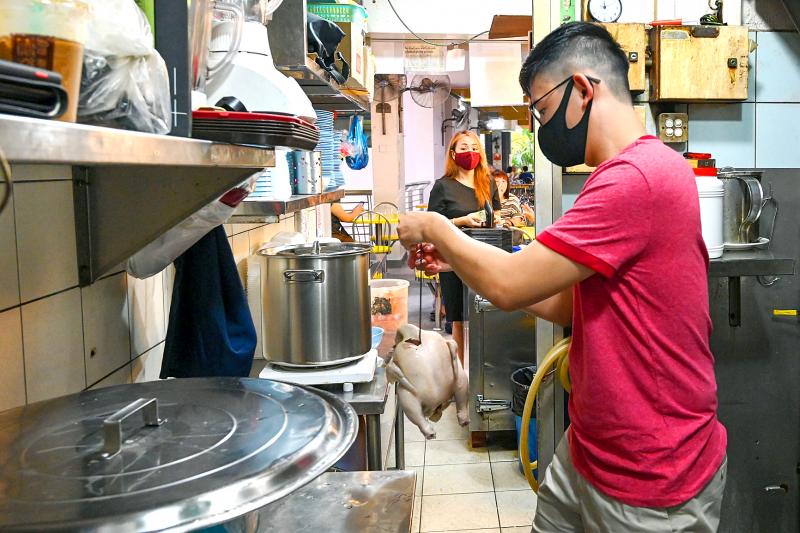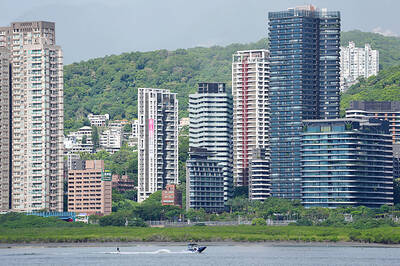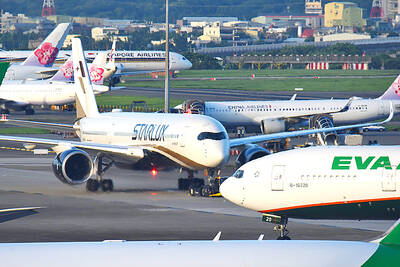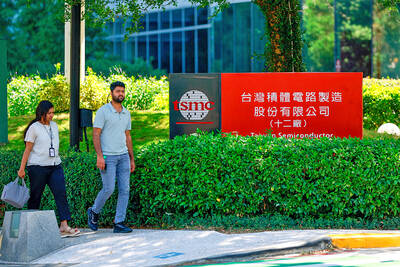After the pandemic torpedoed his chance to work at a Michelin-starred New York restaurant, Lim Wei Keat returned to his roots by becoming a Singapore street-food chef cooking local fare.
The 25-year-old is among a growing number of young street-food vendors — known as “hawkers” locally — fueling hopes that a new generation will preserve the city-state’s culinary traditions.
Singapore is full of open-air food courts offering a wide variety of cuisines influenced by the Southeast Asian nation’s ethnic Chinese, Indian and Muslim populations.

Photo: AFP
Even after the city-state ballooned into an affluent financial hub, the hawker tradition lived on, and remains a central part of everyday life for many.
The UN recognized this tradition as “intangible cultural heritage” in December, describing the centers where hawkers toil as “community dining rooms” that bring together people from diverse backgrounds.
However, many chefs are heading toward retirement — their median age is 59 — and young Singaporeans often shun the trade, stoking fears that hawker traditions and their delicious dishes could be lost.
Lim stumbled into becoming an apprentice hawker, only choosing to do so as he could not take up an internship at a US restaurant last year due to coronavirus travel curbs, but he feels he has found his true calling.
“Local dishes would disappear if young people did not take over stalls or learn [to cook] these dishes,” Lim said.
He got the apprenticeship through government initiatives aimed at safeguarding the street food culture, which has helped dozens of younger chefs join the trade.
Hawkers usually focus on just one or two dishes, from fried rice noodles and turnip cake to curry puffs. Lim chose an ever-popular traditional favorite — Hainanese chicken rice — and likes to cook it the old-fashioned way. “I love chicken rice, so why not start with something that I love and I’m passionate about?”
His mentor, 61-year-old Neo Cheng Leong, has been selling the dish for 30 years.
He makes it from scratch every morning at his stall, cleaning the chicken, poaching it at just the right temperature, then cooking the rice in chicken broth, with ginger and scallion-infused oil.
Cuts of the tender meat are served with a plate of the resultant fragrant rice with garlic chili sauce and sweetened soy sauce, all for just S$3 (US$2.30).
His two sons, both in their early 20s, are studying at university and have no interest in taking over the stall after seeing how hard their parents worked for three decades, Neo said.
“If I don’t teach [apprentices] then this flavor will disappear from Singapore,” Neo said.
Once Lim has completed his government training program — which includes two months of training under Neo, and cooking for a panel of judges — he can rent a stall at a heavily subsidized rate for 15 months.
Still, there are many challenges that make it hard to lure young Singaporeans from better-paid office jobs, such as rising costs and long hours.
And then there is the stigma.
“Back in the day, it was really seen as a profession for those who have no route into life,” said K.F. Seetoh, an influential critic and entrepreneur who created a popular guide for hawker food. “There’s still a school of people who would say ‘what, you want to be a hawker? What’s wrong with you?’”
Hawkers are also forced to keep prices low to compete with rivals, meaning that making ends meet in one of the world’s most expensive cities can be tough.
Shawn Aw, a chef who runs a noodle stall with his 60-year-old mother, admitted it was hard work and said he only made around S$1,000 per month — far below Singapore’s median wage, S$4,500, according to official data.
“You definitely have to come in early and go home late... it’s a bit tough, you have to work hard,” the 32-year-old said.

RECYCLE: Taiwan would aid manufacturers in refining rare earths from discarded appliances, which would fit the nation’s circular economy goals, minister Kung said Taiwan would work with the US and Japan on a proposed cooperation initiative in response to Beijing’s newly announced rare earth export curbs, Minister of Economic Affairs Kung Ming-hsin (龔明鑫) said yesterday. China last week announced new restrictions requiring companies to obtain export licenses if their products contain more than 0.1 percent of Chinese-origin rare earths by value. US Secretary of the Treasury Scott Bessent on Wednesday responded by saying that Beijing was “unreliable” in its rare earths exports, adding that the US would “neither be commanded, nor controlled” by China, several media outlets reported. Japanese Minister of Finance Katsunobu Kato yesterday also

Taiwan’s rapidly aging population is fueling a sharp increase in homes occupied solely by elderly people, a trend that is reshaping the nation’s housing market and social fabric, real-estate brokers said yesterday. About 850,000 residences were occupied by elderly people in the first quarter, including 655,000 that housed only one resident, the Ministry of the Interior said. The figures have nearly doubled from a decade earlier, Great Home Realty Co (大家房屋) said, as people aged 65 and older now make up 20.8 percent of the population. “The so-called silver tsunami represents more than just a demographic shift — it could fundamentally redefine the

China Airlines Ltd (CAL, 中華航空) said it expects peak season effects in the fourth quarter to continue to boost demand for passenger flights and cargo services, after reporting its second-highest-ever September sales on Monday. The carrier said it posted NT$15.88 billion (US$517 million) in consolidated sales last month, trailing only September last year’s NT$16.01 billion. Last month, CAL generated NT$8.77 billion from its passenger flights and NT$5.37 billion from cargo services, it said. In the first nine months of this year, the carrier posted NT$154.93 billion in cumulative sales, up 2.62 percent from a year earlier, marking the second-highest level for the January-September

‘DRAMATIC AND POSITIVE’: AI growth would be better than it previously forecast and would stay robust even if the Chinese market became inaccessible for customers, it said Taiwan Semiconductor Manufacturing Co (TSMC, 台積電) yesterday raised its full-year revenue growth outlook after posting record profit for last quarter, despite growing market concern about an artificial intelligence (AI) bubble. The company said it expects revenue to expand about 35 percent year-on-year, driven mainly by faster-than-expected demand for leading-edge chips for AI applications. The world’s biggest contract chipmaker in July projected that revenue this year would expand about 30 percent in US dollar terms. The company also slightly hiked its capital expenditure for this year to US$40 billion to US$42 billion, compared with US$38 billion to US$42 billion it set previously. “AI demand actually